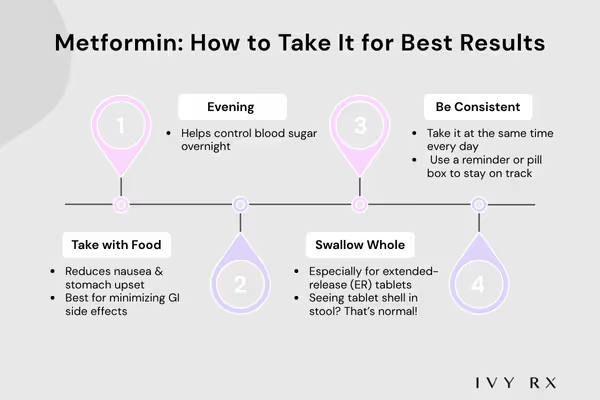Lose weight with Metformin


Metformin Dosage Chart: 2026 Dosing Guide
Getting your metformin dosage right shouldn't be a guessing game that leaves you dealing with stomach issues or ineffective blood sugar control.
Our comprehensive metformin dosage guide and chart breaks down starting doses, maximum limits, and timing recommendations for both immediate-release and extended-release formulations.
We'll walk you through everything from initial dosing to special adjustments needed for specific populations and use cases, so you can feel confident in your treatment plan.
Metformin Overview
Metformin stands as the gold standard first-line treatment for type 2 diabetes, trusted by healthcare providers worldwide for over 60 years.
What is Metformin
Metformin is an oral antidiabetic medicine in the biguanide class that effectively lowers blood glucose levels without causing dangerous low blood sugar episodes. Unlike insulin secretagogue medications, metformin doesn't force your pancreas to produce more insulin, making it safer for long-term use.
The Food and Drug Administration approves metformin for type 2 diabetes treatment, but doctors also prescribe it off-label for weight loss or conditions like skin issues and gestational diabetes.
How Metformin Works
Metformin works through multiple pathways to improve your blood sugar control. It primarily reduces hepatic glucose production in your liver, which is often overactive in people with diabetes mellitus.
The medication also improves insulin sensitivity in your muscles and fat tissue, helping your body use glucose more effectively. This also makes metformin beneficial for skin.
Additionally, metformin slows down intestinal absorption of glucose and activates AMP-activated protein kinase, a key enzyme that regulates metabolism. These combined effects make metformin particularly effective for people dealing with PCOS and other metabolic conditions.
Effective Metformin Dosage for Adults
Getting the right dose is crucial for maximizing metformin's benefits while minimizing side effects.
Immediate-Release Dosage (IR)
Immediate-release tablets require multiple daily doses but offer flexible dosing options. The usual adult dose starts at 500 mg twice daily or 850 mg once daily with meals.
Your doctor will typically increase your dose weekly by 500 mg or 850 mg increments until you reach the optimal blood sugar control. The maximum daily dose for IR tablets is 2550 mg, usually divided into two or three doses throughout the day.
Extended-Release Dosage (ER)
Extended-release tablets offer the convenience of once-daily dosing, typically taken with your evening meal. The starting dose is usually 500-1000 mg once daily.
ER tablets can be increased by 500 mg weekly up to a maximum of 2000 mg daily. Some patients may need to split this into two doses if they experience side effects at higher single doses.
Pediatric Dosage (10+ years)
Children aged 10 and older can safely use metformin following similar principles to adult dosing. The usual pediatric dose starts at 500 mg twice daily with meals.
Healthcare providers carefully monitor young patients and typically cap the maximum dose at 2000 mg daily.
Metformin Dosage Chart
Not sure how much metformin you should be taking? This simple dosage chart breaks it down by formulation, goal, and common starting points.
Dose Adjustments on Metformin for Health Conditions
Special individuals require careful dose modifications to ensure safety and effectiveness.
Renal Impairment
Kidney function is the most critical factor in metformin dosing. When your kidney function declines, metformin can accumulate in your body, increasing the risk of lactic acidosis.
No dose adjustment is needed when your eGFR is above 60 mL/min. However, if your eGFR falls between 45-60 mL/min, your doctor should monitor your kidney function every three to six months. Metformin therapy is not recommended for new patients when eGFR is between 30-45 mL/min, and it's completely contraindicated when eGFR drops below 30 mL/min.
Hepatic Impairment
Liver problems significantly increase your risk of lactic acidosis because your liver normally clears lactate from your blood. The manufacturer recommends avoiding metformin in patients with hepatic impairment.
If you have mild liver problems, your doctor may still consider metformin with careful monitoring, but moderate to severe hepatic impairment is typically a contraindication to metformin therapy.
Congestive Heart Failure
Congestive heart failure can affect how your body processes metformin, potentially increasing lactic acidosis risk. Your doctor will carefully evaluate your heart function before starting metformin and monitor you closely during treatment.
Metformin Administration Best Practices
Following proper administration techniques can significantly improve your experience with metformin.

Take with Food
Always take metformin with meals to minimize gastrointestinal side effects. Food slows absorption and reduces the likelihood of nausea, diarrhea, and stomach upset.
Extended-release tablets work best when taken with your evening meal. This timing helps maintain steady blood glucose levels throughout the night and into the morning.
Swallow Tablets Whole
Never crush, chew, or break extended-release tablets. These slow-release tablets are designed to release metformin gradually over time.
If you see tablet remnants in your stool, don't worry - this is normal for ER tablets. The medication has been absorbed, and you're seeing the inactive shell.
Consistent Timing
Take metformin at the same time each day to maintain steady blood levels. Set reminders on your phone or use a pill organizer to help establish this routine.
Possible Side Effects of Metformin
Understanding potential side effects helps you know what to expect and when to contact your doctor.
Gastrointestinal Disturbances
The most common side effects affect your digestive system. Nausea, diarrhea, bloating, and stomach upset typically occur when starting metformin or increasing doses.
These side effects usually improve within two to four weeks as your body adjusts.
Vitamin B12 Deficiency
Long-term metformin use can reduce vitamin B12 absorption, potentially leading to deficiency. Your doctor should check your serum Vit. B12 levels annually, especially if you've been on metformin for several years.
Symptoms of B12 deficiency include fatigue, weakness, and nerve problems. If detected early, B12 supplementation can prevent or reverse these issues.
Lactic Acidosis
Lactic acidosis is a rare but serious side effect that occurs when lactate builds up in your blood. This emergency condition requires immediate medical attention.
Risk factors include kidney or liver problems, severe illness, excessive alcohol use, and certain medications.
You can lessen the risk of getting lactic acidosis by avoiding excessive alcohol consumption and staying well hydrated.
Always inform healthcare providers about your metformin use before procedures involving contrast agents or CT scans.
Managing Missed or Excessive Doses
Proper dose management prevents complications and maintains effectiveness:
- Take missed doses as soon as you remember, unless it's almost time for your next dose
- Never double up on doses to make up for missed ones
- If you miss multiple doses, contact your healthcare provider for guidance
- Drug overdose signs include severe nausea, vomiting, stomach pain, and difficulty breathing
- Seek immediate medical attention if you suspect an overdose
Start Your Metformin Journey With Ivy Rx Today
With decades of safety data and effectiveness studies, Metformin remains the American Diabetes Association's first-line treatment recommendation.
Ivy Rx makes accessing metformin simple and affordable. For just $30 per month, you get extended-release tablets delivered directly to your door , no insurance hassles, no prior authorization delays, and no surprise costs.
Our licensed healthcare providers conduct thorough online consultations to ensure metformin is right for your specific situation. We also provide ongoing support through our secure patient portal, so you're never alone in your diabetes management journey.
Start your metformin treatment with Ivy Rx today to enjoy sustainable blood sugar management
FAQ
Are Children Prescribed Metformin?
Yes, metformin is FDA-approved for children aged 10 and older with type 2 diabetes. The usual pediatric dose follows adult dosing principles, starting at 500 mg twice daily with meals and titrating up to a maximum of 2000 mg daily based on blood sugar response and tolerance.
What are Some Common Metformin Combination Treatments?
Metformin is frequently combined with other diabetes medications when single-drug therapy isn't sufficient for optimal glycemic control:
- Metformin + insulin for patients with advanced type 2 diabetes requiring intensive blood glucose management
- Metformin + SGLT2 inhibitors (like Jardiance) for additional weight loss benefits and cardiovascular protection
- Metformin + GLP-1 receptor agonists for enhanced weight loss and improved glucose tolerance in obese patients with diabetes

Ivy RX patients
Members of Ivy RX branded medications were paid for their testimonials.
Related
articles

What Is the Strongest Weight Loss Prescription Pill in 2026?
Wondering which prescription pill is strongest for weight loss? Compare FDA-approved options, results, safety, and what to ask your provider in this guide.

15 Celebrities Who Took Ozempic for Weight Loss (& Results!)
See which celebrities have publicly confirmed using Ozempic or other GLP-1s—plus what they’ve said about their experience and results.
%20(1).jpg)
Microdosing GLP-1 Reviews: Real User Results, Experiences, Side Effects & Costs
Curious whether GLP-1 microdosing works? See real user reviews on results, appetite changes, side effects, and costs—plus who benefits most from microdosed semaglutide and tirzepatide.
















.avif)









